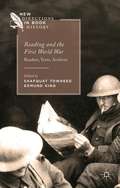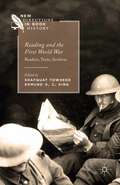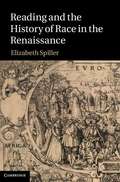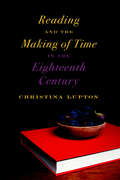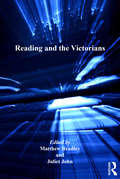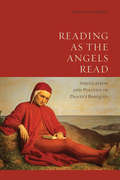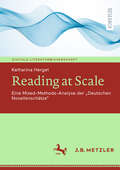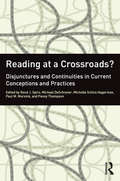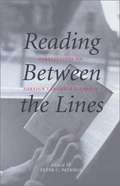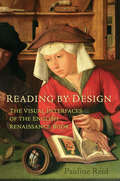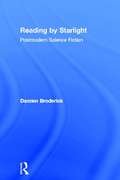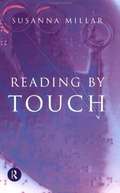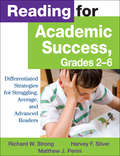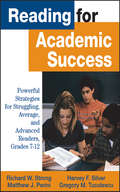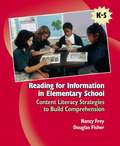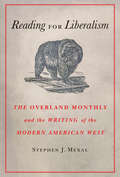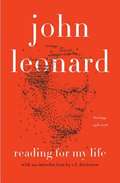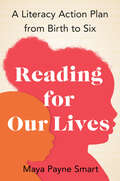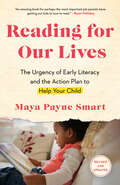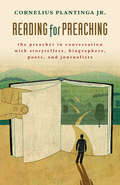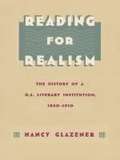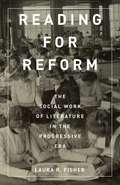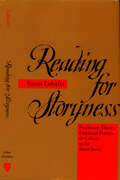- Table View
- List View
Reading and the First World War: Readers, Texts, Archives (New Directions in Book History)
by Shafquat Towheed Edmund G. C. KingRanging from soldiers reading newspapers at the front to authors' responses to the war, this book sheds new light on the reading habits and preferences of men and women, combatants and civilians, during the First World War. This is the first study of the conflict from the perspective of readers.
Reading and the First World War: Readers, Texts, Archives (New Directions in Book History)
by Edmund King Shafquat TowheedRanging from soldiers reading newspapers at the front to authors' responses to the war, this book sheds new light on the reading habits and preferences of men and women, combatants and civilians, during the First World War. This is the first study of the conflict from the perspective of readers.
Reading and the History of Race in the Renaissance
by Elizabeth SpillerElizabeth Spiller studies how early modern attitudes towards race were connected to assumptions about the relationship between the act of reading and the nature of physical identity. As reading was understood to happen in and to the body, what you read could change who you were. In a culture in which learning about the world and its human boundaries came increasingly through reading, one place where histories of race and histories of books intersect is in the minds and bodies of readers. Bringing together ethnic studies, book history and historical phenomenology, this book provides a detailed case study of printed romances and works by Montalvo, Heliodorus, Amyot, Ariosto, Tasso, Cervantes, Munday, Burton, Sidney and Wroth. Reading and the History of Race traces ways in which print culture and the reading practices it encouraged, contributed to shifting understandings of racial and ethnic identity.
Reading and the Making of Time in the Eighteenth Century
by Christina LuptonHow did eighteenth-century readers find and make time to read?Books have always posed a problem of time for readers. Becoming widely available in the eighteenth century—when working hours increased and lighter and quicker forms of reading (newspapers, magazines, broadsheets) surged in popularity—the material form of the codex book invited readers to situate themselves creatively in time. Drawing on letters, diaries, reading logs, and a range of eighteenth- and early nineteenth-century novels, Christina Lupton’s Reading and the Making of Time in the Eighteenth Century concretely describes how book-readers of the past carved up, expanded, and anticipated time.Placing canonical works by Elizabeth Inchbald, Henry Fielding, Amelia Opie, and Samuel Richardson alongside those of lesser-known authors and readers, Lupton approaches books as objects that are good at attracting particular forms of attention and paths of return. In contrast to the digital interfaces of our own moment and the ephemeral newspapers and pamphlets read in the 1700s, books are rarely seen as shaping or keeping modern time. However, as Lupton demonstrates, books are often put down and picked up, they are leafed through as well as read sequentially, and they are handed on as objects designed to bridge temporal distances. In showing how discourse itself engages with these material practices, Lupton argues that reading is something to be studied textually as well as historically.Applying modern theorists such as Niklas Luhmann, Bruno Latour, and Bernard Stiegler, Lupton offers a rare phenomenological approach to the study of a concrete historical field. This compelling book stands out for the combination of archival research, smart theoretical inquiry, and autobiographical reflection it brings into play.
Reading and the Victorians (The Nineteenth Century Series)
by Juliet JohnWhat did reading mean to the Victorians? This question is the key point of departure for Reading and the Victorians, an examination of the era when reading underwent a swifter and more radical transformation than at any other moment in history. With book production handed over to the machines and mass education boosting literacy to unprecedented levels, the norms of modern reading were being established. Essays examine the impact of tallow candles on Victorian reading, the reading practices encouraged by Mudie's Select Library and feminist periodicals, the relationship between author and reader as reflected in manuscript revisions and corrections, the experience of reading women's diaries, models of literacy in Our Mutual Friend, the implications of reading marks in Victorian texts, how computer technology has assisted the study of nineteenth-century reading practices, how Gladstone read his personal library, and what contemporary non-academic readers might owe to Victorian ideals of reading and community. Reading forms a genuine meeting place for historians, literary scholars, theorists, librarians, and historians of the book, and this diverse collection examines nineteenth-century reading in all its personal, historical, literary, and material contexts, while also asking fundamental questions about how we read the Victorians' reading in the present day.
Reading as the Angels Read: Speculation and Politics in Dante's 'Banquet'
by Maria Luisa ArdizzoneAn uncompleted manuscript that combines lyric poetry and prose commentary, the Banquet (or Convivio) is one of Dante Alighieri's most important and least understood philosophical texts. As Maria Luisa Ardizzone shows, its language and logic are deeply connected to medieval culture and the philosophical debates of the thirteenth and early fourteenth centuries.In Reading as the Angels Read, Ardizzone reconstructs the cultural and socio-political background that provided the motivation for the Banquet and offers a bold new reading of this ambitious work. Drawing on a deep knowledge of Dante's engagement with biblical, Augustinian, Neoplatonic, and Aristotelian philosophy, she suggests that the Banquet is not an encyclopedia of learning as many have claimed, but Dante's attempt to articulate a theory of human happiness in which perfect knowledge is the natural basis for a well-organized political community.
Reading at Scale: Eine Mixed-Methods-Analyse der „Deutschen Novellenschätze“ (Digitale Literaturwissenschaft)
by Katharina HergetDie „Novellenschatz“-Reihe Paul Heyses prägt bis heute das deutsche Novellenverständnis: Begonnen mit dem populären „Deutschen Novellenschatz“ wurde ein Sammlungsvorhaben begründet, das eine dezidiert realistische Literaturgeschichte präsentiert. Zusammen mit seinen Fortsetzungen, dem „Novellenschatz des Auslandes“ und dem „Neuen Deutschen Novellenschatz“ ergibt sich ein Korpus aus insgesamt 213 Novellen, das sowohl den (heutigen) Kanon romantischer und realistischer Novellistik als auch das zeitgenössisch Erfolgreiche und Vielgelesene abbildet. In dem Spannungsfeld von realistischem Epochenbewusstsein und programmatischer Bestenauswahl im Angesicht von Massenliteratur erforscht die Studie die „Novellenschatz“-Sammlungen als ‚Arbeit am Kanon‘ – als nicht-narrative Form der Literaturgeschichtsschreibung. Im Mixed-Methods-Verfahren werden hierzu Operationalisierungen verschiedener Skalierungsebenen angewendet, um die Sammlungen und die ihr inhärenten Strukturen zu erfassen: Von hermeneutischen Lektüren über ein Leseexperiment zur heutigen Rezeption realistischer Novellistik hin zu Anwendungen der digitalen Literaturwissenschaft.
Reading at a Crossroads?: Disjunctures and Continuities in Current Conceptions and Practices
by Penny Thompson Rand J. Spiro Michael DeSchryver Michelle Schira Hagerman Paul M. MorsinkThe Internet is transforming the experience of reading and learning-through-reading. Is this transformation effecting a radical change in reading processes as readers synthesize understandings from fragments across multiple texts? Or, conversely, is the Internet merely a new place to use the same reading skills and processes developed through experience with traditional print-based media? Are the changes in reading processes a matter of degree, or are they fundamentally new? And if so, how must reading theory, research, and instruction adjust? This volume brings together distinguished experts from the fields of reading research, teacher education, educational psychology, cognitive science, rhetoric and composition, digital humanities, and educational technology to address these questions. Every question is not answered in every chapter. How could they be? But every contributor has many thoughtful things to say about a subset of these important questions. Together, they add up to a comprehensive response to the issues the field faces as it approaches what may well be—or not —a crossroads. A website devoted to extending discussion around the book in creative (and disjunctive) ways [readingatacrossroads.net] moves it beyond the printed page.
Reading between the Lines: Perspectives on Foreign Language Literacy
by Peter Charles PatrikisThis book presents a collection of new and stimulating approaches to reading in a foreign language. The contributors to the volume all place reading at the heart of learning a foreign language and entering a foreign culture, and they consider issues and methods of language education from such diverse perspectives as cognitive theory, applied linguistics, technology as hermeneutic, history, literary, theory, and cross-cultural analysis. The contributors--teachers of French, German, Greek, Japanese, and Spanish--call for language teachers and theorists to refocus on the importance of reading skills. Emphasizing the process of reading as analyzing and understanding another culture, they document various practical methods, including the use of computer technology for enhancing language learning and fostering cross-cultural understanding.
Reading by Design: The Visual Interface of the English Renaissance Book (G - Reference, Information and Interdisciplinary Subjects)
by Pauline ReidRenaissance readers perceived the print book as both a thing and a medium - a thing that could be broken or reassembled, and a visual medium that had the power to reflect, transform, or deceive. At the same historical moment that print books remediated the visual and material structures of manuscript and oral rhetoric, the relationship between vision and perception was fundamentally called into question. Investigating this crisis of perception, Pauline Reid argues that the visual crisis that suffuses early modern English thought also imbricates sixteenth and seventeenth century print materials. These vision troubles in turn influenced how early modern books and readers interacted. Platonic, Aristotelian, and empirical models of sight vied with one another in a culture where vision had a tenuous relationship to external reality. Through situating early modern books’ design elements, such as woodcuts, engravings, page borders, and layouts, as important rhetorical components of the text, Reading by Design articulates how the early modern book responded to epistemological crises of perception and competing theories of sight.
Reading by Starlight: Postmodern Science Fiction (Popular Fictions Series)
by Damien BroderickReading by Starlight explores the characteristics in the writing, marketing and reception of science fiction which distinguish it as a genre.Damien Broderick explores the postmodern self-referentiality of the sci-fi narrative, its intricate coded language and discursive `encyclopaedia'. He shows how, for perfect understanding, sci-fi readers must learn the codes of these imaginary worlds and vocabularies, all the time picking up references to texts by other writers.Reading by Starlight includes close readings of paradigmatic cyberpunk texts and writings by SF novelists and theorists including Isaac Asimov, Arthur C. Clarke, Brian Aldiss, Patrick Parrinder, Kim Stanley Robinson, John Varley, Roger Zelazny, William Gibson, Fredric Jameson and Samuel R. Delaney.
Reading by Touch
by Susanna MillarThe perceptual, linguistic and cognitive processes involved in sighted reading have been widely studied, but the use of touch raises new issues. Drawing on her research with novice and fluent braille readers, Susanna Millar examines how people initially process braille and how skill with sounds, words, meaning and spelling patterns influence processing. The main focus is on braille, but findings on the "Moon" script, vibrotactile devices, maps and icons are also considered in the context of their practical implications and access to computer technology.
Reading for Academic Success, Grades 2-6: Differentiated Strategies for Struggling, Average, and Advanced Readers
by Harvey F. Silver Richard W. Strong Matthew J. PeriniExamines seven critical areas that can develop average or struggling readers into thoughtful, high-achieving A+ readers who can comprehend, analyze, and summarize different kinds of texts.
Reading for Academic Success: Powerful Strategies for Struggling, Average, and Advanced Readers, Grades 7-12
by Harvey F. Silver Richard W. Strong Matthew J. Perini Gregory M. TuculescuThrough specific examples, real-life scenarios, and diagrams, this book vividly conveys the most fundamental and effective tactics for boosting reading proficiency while enhancing student and teacher performance.
Reading for Christian Schools 5
by Bju StaffA book that helps students build their reading and thinking skills by use of literature materials provided.
Reading for Detail Reading Comprehension Book Reading: Level 3.5 - 5.0
by EdupressWelcome to the Edupress Reading for Detail Reading Comprehension Book. This resource is an effective tool for instruction, practice, and evaluation of student understanding. It includes ideas on how to introduce reading for detail to students, as well as activities to help teach and practice the concept.
Reading for Information in Elementary School: Content Literacy Strategies to Build Comprehension
by Douglas Fisher Nancy FreyReading for Information in Elementary School: Content Literacy Strategies to Build Comprehension was written to give k-5 teachers the tools they need to lay an educational groundwork that promotes students’ success with informational text from the early grades. Packed with research-based, classroom-proven strategies, the book follows a before, during, and after reading format that models the most effective approach to reading for information, focusing on the processes required to develop content literacy. You’ll meet the teachers, sit in on their lessons, witness their students’ responses, and come away from this book with a model for teaching your students to read successfully for information and a handbook of proven strategies to implement.
Reading for Liberalism: The Overland Monthly and the Writing of the Modern American West
by Stephen J. MexalFounded in 1868, the Overland Monthly was a San Francisco–based literary magazine whose mix of humor, pathos, and romantic nostalgia for a lost frontier was an immediate sensation on the East Coast. Due in part to a regional desire to attract settlers and financial investment, the essays and short fiction published in the Overland Monthly often portrayed the American West as a civilized evolution of, and not a savage regression from, eastern bourgeois modernity and democracy.Stories about the American West have for centuries been integral to the way we imagine freedom, the individual, and the possibility for alternate political realities. Reading for Liberalism examines the shifting literary and narrative construction of liberal selfhood in California in the late nineteenth century through case studies of a number of western American writers who wrote for the Overland Monthly, including Noah Brooks, Ina Coolbrith, Bret Harte, Jack London, John Muir, and Frank Norris, among others. Reading for Liberalism argues that Harte, the magazine&’s founding editor, and the other members of the Overland group critiqued and reimagined the often invisible fabric of American freedom. Reading for Liberalism uncovers and examines in the text of the Overland Monthly the relationship between wilderness, literature, race, and the production of individual freedom in late nineteenth-century California.
Reading for My Life: Writings, 1958-2008
by John LeonardJohn Leonard was a lion of American letters. A passionate, erudite, and wide-ranging critic, he helped shape the landscape of modern literature. Reading for My Life is a monumental collection of Leonard's most significant writings—spanning five decades—from his earliest columns for the Harvard Crimson to his final essays for the New York Review of Books. Definitive reviews of Doris Lessing, Joan Didion, Toni Morrison, Don DeLillo, Vladimir Nabokov, and Philip Roth, among others, display Leonard's encyclopedic knowledge of literature and make this book a landmark achievement from one of America's most beloved and influential critics. .
Reading for Our Lives: A Literacy Action Plan from Birth to Six
by Maya Payne SmartAn award-winning journalist and literacy advocate provides a clear, step-by-step guide to helping your child thrive as a reader and a learner.When her child went off to school, Maya Smart was shocked to discover that a good education in America is a long shot, in ways that few parents fully appreciate. Our current approach to literacy offers too little, too late, and attempting to play catch-up when our kids get to kindergarten can no longer be our default strategy. We have to start at the top. The brain architecture for reading develops rapidly during infancy, and early language experiences are critical to building it. That means parents&’ work as children&’s first teachers begins from day one too—and we need deeper knowledge to play our positions.Reading for Our Lives challenges the bath-book-bed mantra and the idea that reading aloud to our kids is enough to ensure school readiness. Instead, it gives parents easy, immediate, and accessible ways to nurture language and literacy development from the start. Through personal stories, historical accounts, scholarly research, and practical tips, this book presents the life-and-death urgency of literacy, investigates inequity in reading achievement, and illuminates a path to a true, transformative education for all.
Reading for Our Lives: The Urgency of Early Literacy and the Action Plan to Help Your Child
by Maya Payne SmartCompletely revised and updated! Now in paperback. An award-winning journalist and literacy advocate provides a clear, step-by-step guide to helping your child thrive as a reader and a learnerToday&’s children face intense pressure to meet rising academic standards and prepare for future careers, but most fall dangerously short. Early struggles with language and literacy often snowball into lasting disadvantages. Millions of U.S. kids don&’t learn to read well in elementary school, driving low adult literacy rates and threatening the nation&’s economic productivity, public health, and social equity.In Reading for Our Lives, journalist Maya Payne Smart shows that the literacy crisis starts at home. Too many parents expect schools to unlock their child&’s reading potential, unaware that even the best classroom instruction (which most don&’t get) can&’t make up for weak early preparation or inconsistent support outside of school. Smart breaks down the latest research to show parents how to do their part to build essential literacy skills. She busts the myth that bedtime stories are parents&’ greatest contribution to kids&’ reading development. She advocates instead for weaving a range of simple, fun, free literacy habits and activities into everyday family life—and shows you how to do it.With optimism and evidence, Reading for Our Lives delivers a clear call to action and a path forward for families, schools, and communities to beat the literacy crisis together.
Reading for Preaching: The Preacher in Conversation with Storytellers, Biographers, Poets, and Journalists
by Cornelius Plantinga Jr.In Reading for Preaching Cornelius Plantinga makes a striking claim: preachers who read widely will most likely become better preachers.Plantinga -- himself a master preacher -- shows how a wide reading program can benefit preachers. First, he says, good reading generates delight, and the preacher who enters the world of delight goes with God. Good reading can also help tune the preacher’s ear for language -- his or her primary tool. General reading can enlarge the preacher’s sympathies for people and situations that she or he had previously known nothing about. And, above all, the preacher who reads widely has the chance to become wise.This beautifully written book will benefit not just preachers but anyone interested in the wisdom to be derived from reading.Works that Plantinga interacts with in the book includeThe Kite Runner, by Khaled HosseiniEnrique's Journey, by Sonia NazarioSilence, by Shusaku Endo"How Much Land Does a Man Need?" by Leo Tolstoy"Narcissus Leaves the Pool" by Joseph EpsteinLes Miserables, by Victor Hugo. . . and many more!
Reading for Realism: The History of a U.S. Literary Institution, 1850–1910
by Nancy GlazenerReading for Realism presents a new approach to U.S. literary history that is based on the analysis of dominant reading practices rather than on the production of texts. Nancy Glazener's focus is the realist novel, the most influential literary form of the nineteenth and twentieth centuries--a form she contends was only made possible by changes in the expectations of readers about pleasure and literary value. By tracing readers' collaboration in the production of literary forms, Reading for Realism turns nineteenth-century controversies about the realist, romance, and sentimental novels into episodes in the history of readership. It also shows how works of fiction by Rebecca Harding Davis, Henry James, Nathaniel Hawthorne, and others participated in the debates about literary classification and reading that, in turn, created and shaped their audiences.Combining reception theory with a materialist analysis of the social formations in which realist reading practices circulated, Glazener's study reveals the elitist underpinnings of literary realism. At the book's center is the Atlantic group of magazines, whose influence was part of the cultural machinery of the Northeastern urban bourgeoisie and crucial to the development of literary realism in America. Glazener shows how the promotion of realism by this group of publications also meant a consolidation of privilege--primarily in terms of class, gender, race, and region--for the audience it served. Thus American realism, so often portrayed as a quintessentially populist form, actually served to enforce existing structures of class and power.
Reading for Reform: The Social Work of Literature in the Progressive Era
by Laura R. FisherAn unprecedented examination of class-bridging reform and U.S. literary history at the turn of the twentieth century Reading for Reform rewrites the literary history of late nineteenth and early twentieth century America by putting social reform institutions at the center of literary and cultural analysis. Examining the vibrant, often fractious literary cultures that developed as part of the Progressive mandate to uplift the socially disadvantaged, it shows that in these years reformers saw literature as a way to combat the myriad social problems that plagued modern U.S. society. As they developed distinctly literary methods for Americanizing immigrants, uplifting and refining wage-earning women, and educating black students, their institutions gave rise to a new social purpose for literature.Class-bridging reform institutions—the urban settlement house, working girls&’ club, and African American college—are rarely addressed in literary history. Yet, Laura R. Fisher argues, they engendered important experiments in the form and social utility of American literature, from minor texts of Yiddish drama and little-known periodical and reform writers to the fiction of Edith Wharton and Nella Larsen. Fisher delves into reform&’s vast and largely unexplored institutional archives to show how dynamic sites of modern literary culture developed at the margins of social power. Fisher reveals how reformist approaches to race, class, religion, and gender formation shaped American literature between the 1880s and the 1920s. In doing so, she tells a new story about the fate of literary practice, and the idea of literature&’s practical value, during the very years that modernist authors were proclaiming art&’s autonomy from concepts of social utility.
Reading for Storyness: Preclosure Theory, Empirical Poetics, and Culture in the Short Story
by Susan LohaferThe short story has been a staple of American literature since the nineteenth century, taught in virtually every high school and consistently popular among adult readers. But what makes a short story unique? In Reading for Storyness, Susan Lohafer, former president of the Society for the Study of the Short Story, argues that there is much more than length separating short stories from novels and other works of fiction. With its close readings of stories by Kate Chopin, Julio Cortázar, Katherine Mansfield, and others, this book challenges assumptions about the short story and effectively redefines the genre in a fresh and original way.In her analysis, Lohafer combines traditional literary theory with a more unconventional mode of research, monitoring the reactions of readers as they progress through a story—to establish a new poetics of the genre. Singling out the phenomenon of "imminent closure" as the genre's defining trait, she then proceeds to identify "preclosure points," or places where a given story could end, in order to access hidden layers of the reading experience. She expertly harnesses this theory of preclosure to explore interactions between pedagogy and theory, formalism and cultural studies, fiction and nonfiction. Returning to the roots of storyness, Lohafer illuminates the intricacies of classic short stories and experimental forms of surreal, postmodern, and minimalist fiction. She also discusses the impact of social constructions, such as gender, on the identification of preclosure points by individual readers. Reading for Storyness combines cognitive science with literary theory to present a compelling argument for the uniqueness of the short story.
